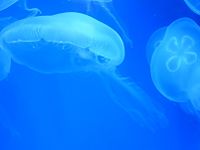DeepDream
DeepDream is software from Google employee Alexander Mordvintsev from the computer vision division , which is based on the principle of an artificial neural network . A convolutional neural network , which actually serves to recognize and classify content in images, is used to change the input image, with structures being inserted into the image that look like dogs or buildings, for example. Since the results are reminiscent of recognizing faces or animals in clouds (see pareidolia ), this process is often referred to in the media as “dreaming a computer”.
functionality
In order to generate such images, a neural network is first trained using sample images so that it correctly recognizes the objects depicted in this data set. The parameters of the network are determined in the process. Instead of classifying images with this network, DeepDream changes an entered image in such a way that selected parts of the network are particularly strongly activated. The original learning process is now practically reversed: If you had pictures of dogs before and changed the parameters of the network so that the answer for this input data is "dog", you now take any picture and let the software change the picture so that as the response of the network "dog" comes out. However, this is a gross simplification, because one can not only demand a high activation of certain output neurons, the response of which can be interpreted humanly, but also for hidden layers. For these, it is usually not known which image content is responsible for a high level of activation. This is also heavily dependent on the images with which the network was originally trained. However, this can be visualized with the help of DeepDream. If, for example, high activations are required in parts of the upper layers of the network, the resulting image shows rather simpler patterns of edges and lines, since these parts of the network respond to simple structures. More complex structures are then recognized in deeper layers, which is why the objects with which the network was trained can be recognized in the resulting images.
Use to create computer art
After Google published the source code of DeepDream as open source , various generators were created with which the user can artistically alienate images. The oft-cited similarity of so-created images to LSD - and psilocybin -induced pseudo-hallucinations points of a functional similarity between artificial neural networks and certain layers of the visual cortex out of man.
The story of DeepDream
The basis for the development of the DeepDream engine is the great progress made by neural networks in the recognition of graphic and linguistic patterns. Google then launched the Inceptionism program to learn how to develop and improve this pattern recognition ability. This resulted in the DeepDream software, which Google made available to the public in summer 2015.
The practical use of image generation
The ability to generate images with the help of the neural network was not originally used to create computer art. The developers wanted to research whether the software developed a correct idea of a term. Simplified example: The recognition software was only fed with images showing dogs with collars. In this case, the artificial neural network behind the engine would inevitably assume that a collar is an indispensable part of a dog and would therefore always represent it that way.
Web links
Individual evidence
- ↑ Airen: Deep Dream by Google teaches computers to dream. In: welt.de . July 21, 2015, accessed October 7, 2018 .
- ↑ https://www.theguardian.com/technology/2015/jun/18/google-image-recognition-neural-network-androids-dream-electric-sheep
- ↑ a b c https://research.googleblog.com/2015/06/inceptionism-going-deeper-into-neural.html
- ↑ https://github.com/google/deepdream
- ↑ http://www.chip.de/news/Traumbilder-von-Google-Deep-Dream-Engine-einfach-kostenlos-testen_81893915.html
- ^ Adrienne LaFrance: If You Give a Robot Acid . In: The Atlantic . ( theatlantic.com [accessed April 11, 2017]).
- ↑ https://web.archive.org/web/20150708233542/http://googleresearch.blogspot.co.uk/2015/07/deepdream-code-example-for-visualizing.html


